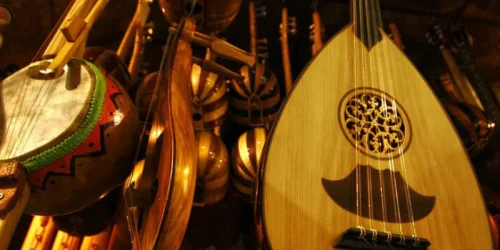
Arabic music is the music of the Arabic-speaking regions of West Asia and North Africa that share common musical practices, ideas, and instruments. Get this music on https://www.melodyloops.com/music-genres/arabian/. From the tenth century onwards, Arab music retained close contact with Persian music theory, song, and instruments. During the Ottoman Empire from the thirteenth century, Turkish culture dominated the life of Arab music. The clear Arab realization was reborn in the nineteenth century, introduced by Islamic opponents of imperialists, scholars, and artists. An important change took place during the Arab colonial rule by European empires after World War I when the Arabs began to adopt Western styles and musical instruments. From the middle of the twentieth century to the present day Arab music was influenced by popular American music as well, especially jazz and hip hop.
The Arabs knew music long before the advent of Islam, although it was not a major artistic expression in pre-Islamic society. In the Arabian city of Ukaz, poets and singers occasionally met and presented their talents and gifts to the wealthy Arab merchants and aristocrats of the city. Female music poets followed heroes on the battlefields, inspiring them with hymns. Because of their influential and entertaining power, the artists and poets of pre-Islamic Arabia occupied a prominent position in the social center.
Because of their influential and entertaining power, the artists and poets of pre-Islamic Arabia occupied a prominent position in the social center.
Rhythm in Arabic music
Rhythm Arabic music is usually a free rhythm. Metric rhythms are organized into rhythmic patterns of various times — 3, 4, 7, 8, or 10 lengths, up to over a hundred. These patterns can vary in decoration on performance, such as enhanced melodic decoration.
Arabic traditional music
Instrumental music can be played by a solo artist as a self-portrait (taqsim), or a collection. A representative collection of ancient Middle Eastern Arabic music is the takht. In Egypt, Syria, Lebanon, Palestine, and Jordan, takht includes oud, kamanjah (violin), ney, qanun, and two main instruments, the riq and the darbuka.
Today, Arabic music is one of the richest and most vibrant music traditions, reflecting its historical connection with the various cultures from East and West. You can listen to the best of Arabic music. The combination of tunes, tones, melodies, and musical instruments makes for a beautiful collection of genres and genres, such as classical, rai, gnawa, pop, andalusian, and khaliji. And as they have historically done, Arab artists continue to produce forms of art and music that contribute to enriching communities around the world.
© 2022, Logan. All rights reserved.











